Sand is so much more gentle on gel coat than sharp rocks.
What I have discovered tho, that even if not gouging the hull's finish, sand is rather abrasive over time.
Dragging a loaded sea kayak to the water's edge can wear through the gel coat down to the laminate in a relatively short time.
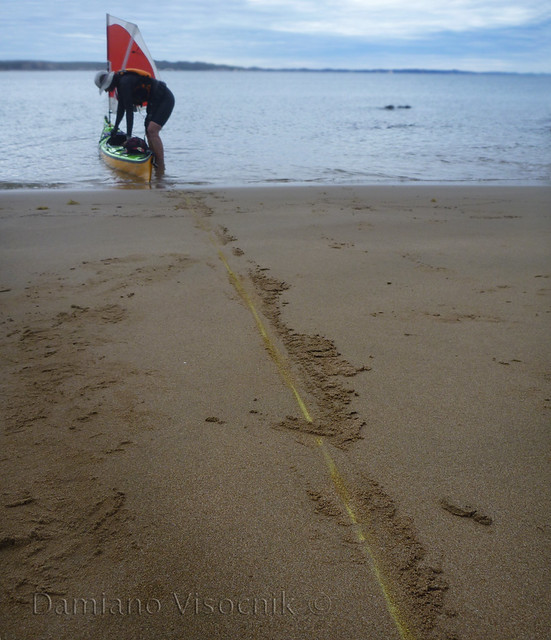
gel coat skid mark left by dragging the kayak
Typically I would take care of my kayaks by applying a resin strip (epoxy mix) to the hull. From bow to stern I lay UV stabilized epoxy (mixed with graphite and pigment) several layers thick to act as a sacrificial layer that every couple of years will need touching up. I prefer epoxy because it wears better (higher abrasion resistance) than gel coat; it takes longer to apply but I like the results. I won't describe here how to create a keel strip (there is plenty of very good info on the net) but I will say that it adds some degree of protection in areas of wear.
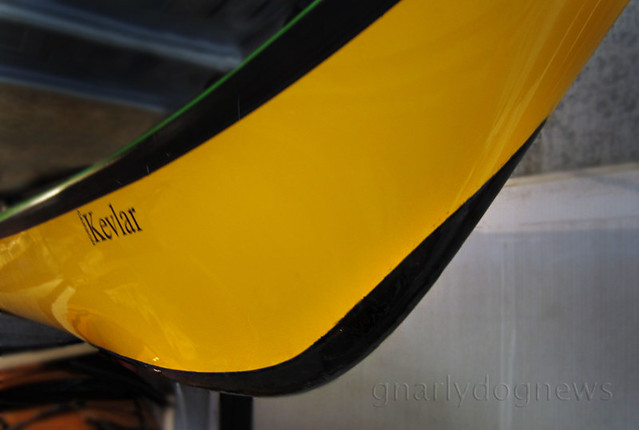
conventional resin (or gel coat) keel strip
On some kayaks the gel coat is very thick and it will take a while for sand to rub it off but on high end light kayaks the manufacturers try to keep the weight down and apply only a thin layer. Of course I could stop and exit the kayak before I hit the beach but often I launch and land in surf conditions where the most practical and safe way is to simply start/stop right on the wet sand. My light carbon/Kevlar hull was starting to show a bit of wear and I decided to try a new style of keel strip. I have heard of KeelEazy before but I have never seen a kayak with one. On my recent trip to USA I visited Kayak Academy in Washington's North West. Here I saw their entire fleet of rental kayaks covered with KeelEazy strip. I wanted to try some for myself. I decided I was going to cover part of the keel line, just the "pointy" areas where most of the abrasion occurs. The material resembles thick PVC backed with an industrial strength self adhesive glue.
The instructions were clear: clean the kayak's hull and apply neatly.

rounding the edge
I trimmed the edges to create a rounder corner to prevent peel-back once applied. I cleaned the hull with acetone making sure it would be really clean.
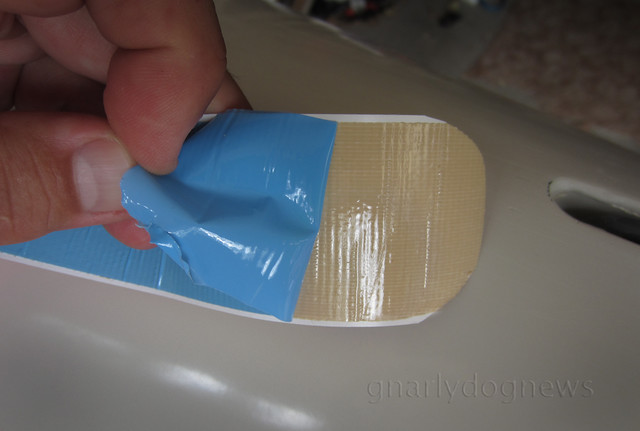
peeeling the adhesive backing
The glue on the KeelEazy strip is very strong and the blue protective backing is hard to get started
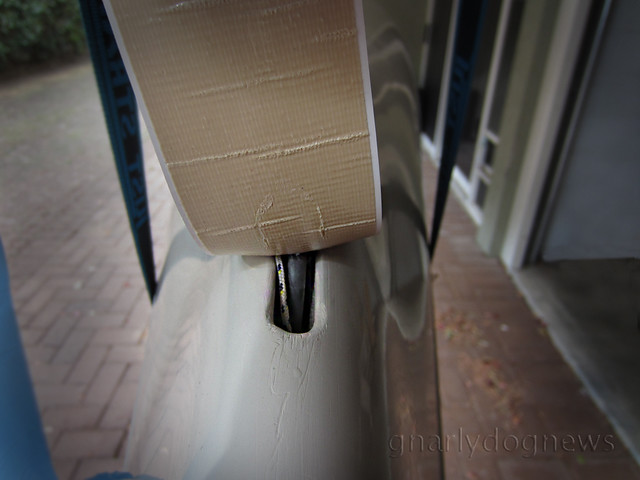
applying over skeg box
I carefully centered the strip over the skeg box opening and pressed down lightly to then check alignment. Once I was happy with the position I lifted the tape back up and pulled on it to stretch it slightly. The tape tends to then fall over the edge of the keel and contour the hull's shape. Around the bow and stern keel's curve I used a heat gun set on mild and softened the tape a bit while stretching it. It conformed over the curve perfectly without wrinkling. I applied the pressure of the palm of my hand and let it cool down.
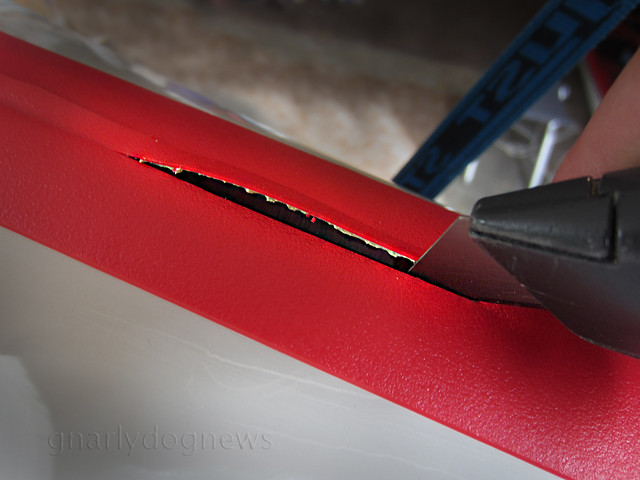
trimming back around skeg box
Around the skeg box I used a utility knife and trimmed away the strip over the opening of the skeg's blade leaving little tabs to push them into the recess.

skeg box finished
The whole application of the KeelEazy strip took me less than an hour; a far cry compared to a typical "wet" application of a gel coat style keel strip. I have however my reservation over the effectiveness of the KeelEazy strip and I can see potential problems happening from a "half" strip. While the protection over the centre of the hull is not as critical, in retrospect I think a continuous strip might be a better solution and prevent the strip's leading edge from peeling back when dragged over a sandy beach. Time will tell if the strip is as effective as my resin ones.
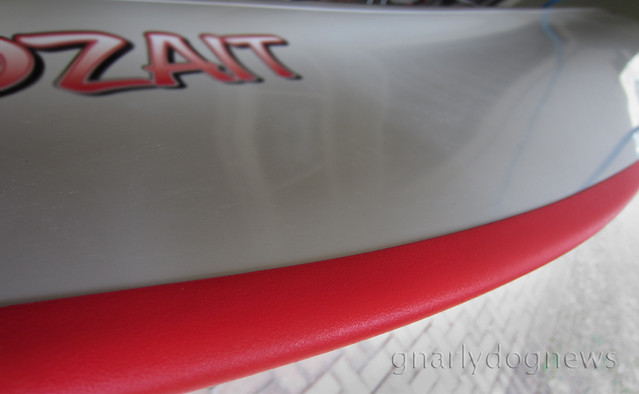
wrinkle free around curve

Hi Gnarlydog
ReplyDeleteI use something called sand blasting tape. It is quite cheap and a really DIY-projekt. It last almost an entire season. And cost 10 US $ for taping in 4-5 kayaks.
Thomas, thank you for the tip. I had a quick look at sandblasting tapes and found a huge variety. Any particular tape (brand/model) better than others?
DeleteGnarlydog, you maybe know that Scotland was once a Viking controlled area. So if you think that the Scotsmen are cheap.....
DeleteI went for the cheapest one in a car repair shop. It is app. 5 cm wide and 1 mm thick with 50 meters in the roll - and the tape is black. I have (in Danish) an instruction on my homepage: http://www.kajakgal.dk/?p=4236
Thank you Thomas. I will try to source a similar tape here in Australia (from an automotive shop) and give it a try.
DeleteGnarly, I find the KeelEazy tape very good. Can you tell me why you have reservations about the protection it will give?
ReplyDeleteChris
Chris, I went for the "half length" option (only bow and stern, no mid-ship) and I have noticed that the leading edge on the stern section of KeelEazy has started to peel back already after a couple of landings on soft sand.
DeleteNot sure how long it will last.
I didn't want to spend too much money on a product that to me was unproven. Maybe a full length strip might work but I am not willing to shell out more $ to see IF it does work better than a traditional wet application fibreglass keel strip.
Happy to test if KeelEazy is willing to supply the material tho.
I have a keelEazy strip on my boat, full length. It's been there a couple of years now and has worn well. There are a couple of dings in the strip that would have been chips in my boat for sure. But in my application I didn't have as neat and clean a section of the skeg area as you do. The tape eventually, this last season, started to come off the boat around the skeg and I eventually just cut it off away from that area. Still have the tape on the rest of the keel. It did really well and was supper easy to apply (I'm interested in seeing how it comes off), however I am ready now to try my hand at putting on a fibreglass epoxy strip!
ReplyDeleteSand blasting tape - awesome tip
ReplyDelete